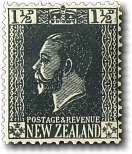
1915 King George V Local Print
«previous next»

| Cat. | Mint Unhinged | Mint Hinged | Fine Used | |||||
| 1½d | Grey Black | 31a | $45.00 | $25.20 | $2.70 | |||
The surface printed 1½d stamp was printed using a plate engraved locally by W.R. Bock. However, the stamps were not up to the required standard and were replaced by plates produced by Perkins, Bacon in London along with the 2d and 3d plates in the 'King George V Surface Print' issue.

The local print is very coarsely drawn with a diagonal background pattern and with rather poorly spaced diagonal shading lines on the face and neck. The surface print stamps have a similar background but with horizontal shading on George V's face and neck. The recess print stamps have diagonal shading on George V's face and neck and a very fine and complex pattern of alternating arcs with a criss-cross hatching over the top giving the appearance of almost solid shading.
If you have any questions or comments please contact us - we'd love to hear from you.
Catalogue ·
1913 ·
1915 ·
1920 ·
Definitives ·
The Royal Family
Order Form · Currency Converter · Privacy Policy
What to Expect · Contact Us · Links
Order Form · Currency Converter · Privacy Policy
What to Expect · Contact Us · Links
This page was last updated on 18 Nov 2025
All content and images copyright © 2008 - 2025 StampsNZ
All content and images copyright © 2008 - 2025 StampsNZ